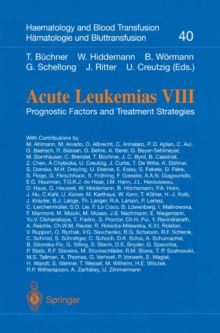
Modern Trends in Human Leukemia VIII : New Results in Clinical and Biological Research Including Pediatric Oncology PDF
Edited by Rolf Neth, Robert C. Gallo, Melvyn F. Greaves, Gerhard Gaedicke, Sven Gohla, Klaus Mannweiler, Jorg Ritter
Part of the Haematology and Blood Transfusion Hamatologie und Bluttransfusion series
Description
You see things, and sa)' why? But I dream 1hings that never were, and I say, 11'hy 110t?
George Bernhard Shaw Far ahead of his time, June 1st, 1909, Alexander Maximov communicated in a lecture, given in the Charite in Berlin, the fundamental knowledge, that there exists a lymphoid hemopoetic stem cell.
Alexander Friedenstein explained that during the following years, Maximov also showed that the idea of interaction between hemopoetic cells and their stroma to be one of the most significant experiences.
Monoclonal antibodies, recombinant DNA technics and the improvement of tissue culture models are the major developments to improve our possibilities to clarify growth and differentiation functions of hemopoetic cells.
During the last two decades it was shown that soluble products, released from T cells, were not only involved in inducing B cells to produce specific immunoglobulin secretion after antigen stimulation.
Furthermore, lymphokines together with other cytokines regulate the growth and differentiation of hemopoetic cells.
As I have learned from Dick Gershon, our knowledge of the cellular basis for immunoregulation has come a long way since 450 B.C.
Thucydides comments on the possible role of immune response in controlling the Black Death.
Dick Gershon speculated that no scientific interest for these interesting observations was put forth at that time.
Perhaps the problems, the Athenians were having with the Spartans, converted money from basis research into the military budget.
Information
-
Download - Immediately Available
- Format:PDF
- Publisher:Springer Berlin Heidelberg
- Publication Date:06/12/2012
- Category:
- ISBN:9783642746215
Information
-
Download - Immediately Available
- Format:PDF
- Publisher:Springer Berlin Heidelberg
- Publication Date:06/12/2012
- Category:
- ISBN:9783642746215










